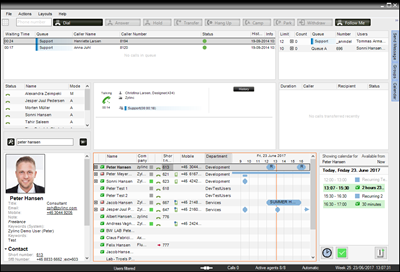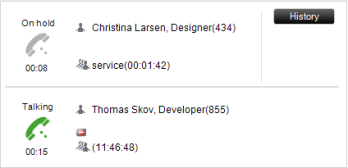In Zylinc Attendant Console, agents typically transfer most calls.
Attendant Console integrates call handling with calendar and search features. That helps you quickly find individuals across your entite organization, based on skills, availability, etc.
This way, you can quickly transfer inquiries to the people who are most suited to handle them.

In order to receive calls your status must be Active. You can also receive calls in Standby status, but only if the call situation gets critical.
To verify your status, select Actions > Status in the Attendant Console window's top menu.
Always verify with your colleagues before you change your status away from active: If you're the last agent in active status, and you then change your status to inactive or offline, the queue may automatically close, because there's no one left to answer calls. Ask your Zylinc administrator if you're in doubt.
You can receive calls in two modes: Either calls are automatically assigned to you, or you can manually select the calls that you want to answer.
To change your mode, select Actions > Mode.
For step-by-step information about how to answer and handle calls, see Handle calls in Zylinc Attendant Console.
To view other agents, who are online and who handles calls from some of the same queues that you handle, use the Agents overview

Status determines if agents can answer calls:
![]() Active
Active
![]() Active, but busy on the phone
Active, but busy on the phone
![]() Inactive agents do generally not handle calls, but they can still view waiting calls, and answer a call if they actively select it.
Inactive agents do generally not handle calls, but they can still view waiting calls, and answer a call if they actively select it.
Agents' status can also be Offline, but when that's the case, they're not displayed in the Agents overview. Agents can also get the status Unreachable by the system, for example if their phones aren't working, or if they don't answer the calls that they get.
Modes determine how agents can answer calls:
M Manual mode: Agents manually select the calls that they want to answer.
A Automatic: Calls are automatically assigned, unless agents are Inactive.
F Follow-me: Calls are forwarded to a specified number, for example an agents mobile phone.
To change your mode, select Actions > Mode in the Attendant Console window's top menu.
In the Queues overview, you can view the status of the queues that you handle.

You can also see which other agents handle the queues, and whether they are primary, secondary or standby on each queue. Primary and secondary agents can automatically answer calls from the queue, while standby agents only answer calls if the queue gets too big.
If the Limit column is displayed, you can see how many calls a queue can hold. If the queue doesn't have a call limit, the column will show 0.
When a queue has a call limit, the Count column will gradually get colored if calls are waiting. The color will cover an increasing part of the column, and the color will gradually change from yellow to red as the queue approaches its call limit.
Some organizations also use colors to be able to distinguish between queues. In the illustration, the blue color of Queue C is an example of that. Such queue colors don't represent how busy queues are.
To manage which queues you get calls from, select Actions > Administer Queues in the Attendant Console window's top menu.
The Incoming calls overview displays all incoming calls in your queues.

If you're in automatic mode, you get calls automatically, and all you need to do is click the Answer button in the top part of the Attendant Console window to answer them.
If you are in manual mode or in automatic mode with inactive status, you select the required call in the Incoming calls overview, and then you click the Answer button.
The oldest call in is selected by default, so all you need to do to answer that call is to click Answer. You only need to manually select a call if you wish to answer a different call.
In the Waiting Time column, you can see if call waiting times live up to your organization's service goals. When a new call is queued, it'll slowly turn yellow after a while. If the call has been waiting long enough for the service goal to be in jeopardy, it'll turn orange. If it turns completely red, the service goal has been exceeded.
Individual queues may have different service goals. Ask your Zylinc administrator if you're in doubt.
If a call is displayed in bold, and all other calls are gray, the call in bold is specifically for you. You'll typically only get such calls if transfers fail, or if other agents transfer them to you specifically. If you don't answer the call, it'll may become available to everyone after a while, depending on how your system is configured.
Likewise, a call intended specifically for another agent may become available to you and other agents if the original agent doesn't answer it. When that's the case, the call will have the status Transferring (name of original agent).

In the Active calls overview, you can view information about your ongoing calls. Incoming calls appear in the top part of the overview, and outgoing calls (for example when you call someone in order to transfer a call to them) appear in the bottom part.

You can only have one incoming call and one outgoing call active at a time. This means that you can't answer new incoming calls while you have an active call.
See more in Handle calls in Zylinc Attendant Console.
To quickly find the right people in your organization, and view whether they're available, use the View people, resources, and availability. In many organizations, the Time overview also lists other resources, such as meeting rooms, projectors, etc. The Time overview provides all the information you need to be able to transfer calls to the right people and provide the best possible service.
If the Time overview contains many people and other resources, use Search to filter the Time overview according to your needs.
This is help for Zylinc version 6.0. To view Zylinc unified help for other versions, go here.
© 2021 Zylinc A/S • Disclaimer
Help version: 22 January 2021 13:21:22
Share this topic: